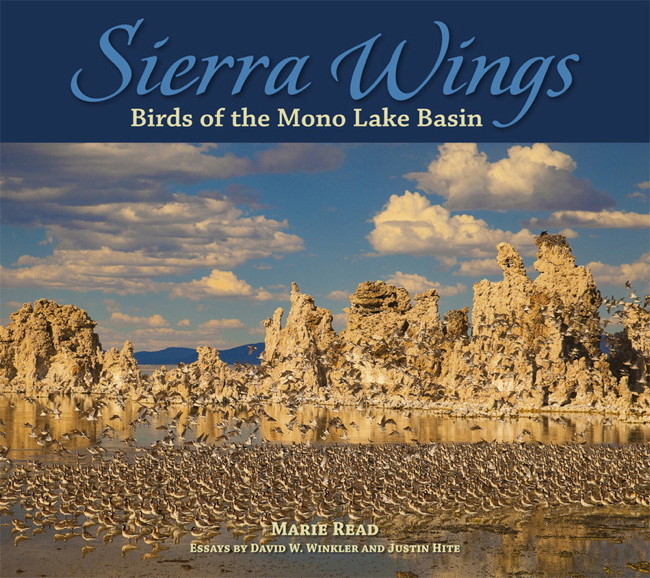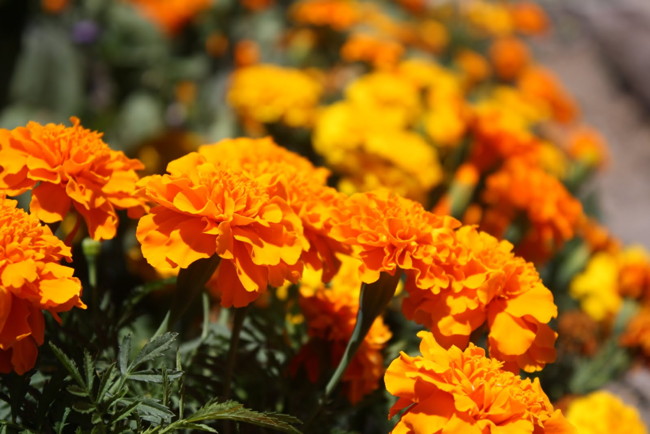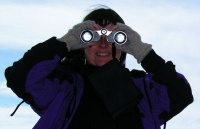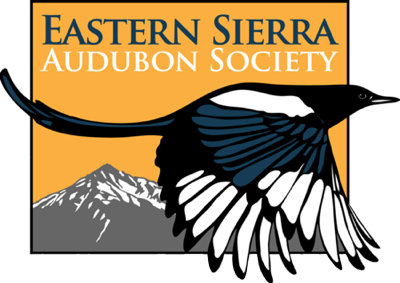
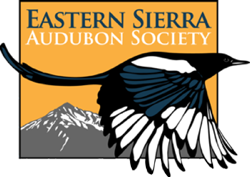
Sierra Wave
Newsletter
Volume 33, Number 1
September-October, 2014
Sierra Wave Newsletter
Volume 31, Number 4
March-April, 2013
Contents
- Events:
- Features:
- Reports:
- Business
Events
September 25th (Thursday):
Sierra Wings: Birds of the Mono Lake Basin with Marie Read
Join us at 7pm on September 25th at the at the BLM/Forest Service Office in Bishop (by the DMV) for this program and book event with author / photographer Marie Read. Spellbinder Books will be there with signed copies of her beautiful new book for sale. Note that this program is on a Thursday night rather than our usual Wednesday. Doors open at 6:30pm.
Sierra Wings: Birds of the Mono Lake Basin
Nationally known bird photographer, Marie Read, takes us on a journey exploring the birdlife of the Mono Lake Basin. Marie’s stunning photography, now featured in her newly released book Sierra Wings: Birds of the Mono Lake Basin, reveals the fascinating lives of the birds that breed or migrate through this spectacular birding hotspot.
Iconic Mono Lake is famous for bizarre tufa towers rising from the surface of its highly alkaline water. Teeming brine shrimp and alkali flies attract huge numbers of breeding and migratory birds, including California Gulls, Wilson’s and Red-necked phalaropes, and Eared Grebes. The surrounding sagebrush scrub, pinyon-juniper, Jeffrey pine and conifer-aspen forests support many other species of birds as well.
Delve into the hidden lives of birds such as Pinyon Jay, Violet-green Swallow, Sage Thrasher, Lewis’s and Black-backed Woodpeckers, and American Dipper! Enjoy Marie’s stories from the field and learn how she obtained some of the behavior and action shots in the book.
About the Author
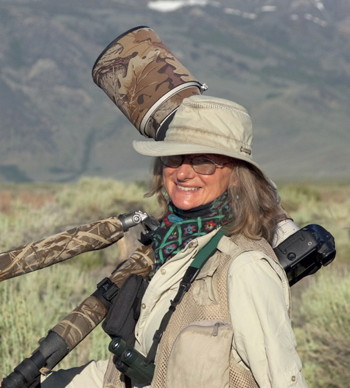
Marie Read
Marie’s images and articles have appeared in magazines such as Living Bird, Bird Watching, Nature’s Best, Birds & Blooms, and National Wildlife, as well as in books, calendars, and websites. She has authored two previous books: Secret Lives of Common Birds: Enjoying Bird Behavior Through the Seasons (Houghton Mifflin, 2005), and Common Birds & Their Songs (coauthored with Lang Elliott, Houghton Mifflin, 1998).
You can see Marie’s work at www.marieread.com
Spellbinder Books of Bishop will be at the program with signed copies of the book for purchase.
See you THURSDAY, September 25th!
See you there at the U.S. Forest Service/BLM Building in Bishop on West Line Street, near the DMV. Doors open at 6:30, with the presentation starting at 7:00pm.
Please Note: This program falls on a THURSDAY, rather than our usual Wednesday night program.
For more information contact Jenny Richardson (email jennyn63@gmail.com or call 760-920-8541). Also, check back to the programs page for updates to the list of future speakers. Everyone is welcome to attend all programs!
Back to Top
October Program (Date and Venue TBA): Trick or treat… it’s Bats… Eeeek!
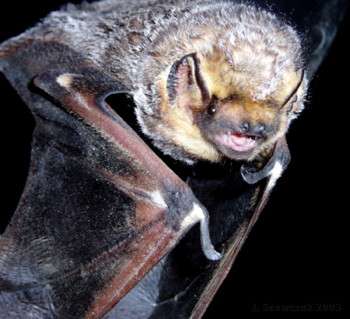
Hoary bat, Lasiurus cinereus
Photo by Joseph M. Szewczak
Trick or treat…it’s Bats…. Eeeek!
But wait… did you know that bats are a vital part of the ecosystem, and that California is home to 23 different species of these marvelous creatures? Come discover the wonderful world of our local bats, and bust some of the Halloween-ish myths about these animals. Not the creepy stuff of horror film and campfire legend, bats are key nocturnal insect predators and equipped with fascinating adaptations for life in tiny roost spaces and the vastness of the night sky. Worldwide, it's estimated that one in every four mammals on the planet is a bat, and they employ a fascinating array of survival strategies and life histories. From fruit-eaters to insect-eaters, migratory bats to hibernating bats, there’s a bat to charm even the most timid soul.
Wildlife biologist Leila Harris will share life histories and cool facts about some of our native bat species, many of which occupy the hills, mines and forests of Mono and Inyo Counties. Learn about ongoing research, conservation challenges and what you can do to support bat-friendly habitats and communities.
Special treat: Ever wanted to see a bat up close? Following the presentation, weather allowing, the group is invited to take a walk through the adjacent conservation area with Leila and her trusty bat detector, to observe science in action. If the local bats cooperate, we’ll have the opportunity to hear the echolocation chirps of passing bats, and the chance to see biologists capture and release bats to contribute data to a local study. (Please note: October is getting late in the active season for our local bats, so the weather will determine our fortune for the field component of this program.)
For more information contact Jenny Richardson (email jennyn63@gmail.com or call 760-920-8541). Also, check back to the programs page for updates to the list of future speakers. Everyone is welcome to attend all programs!
Back to Top
Upcoming ESAS Field Trips and Other Events
Bishop COSA, Bird Walk and Census, Saturday, September 13, 7:30am and Saturday, October 11, 8:30am
[Ed. Note: COSA walks are held on the second Saturday of every month, unless otherwise indicated]
Our Conservation Open Space Area (COSA) Bird Walks and Censuses will be held on the second Saturday of September (9/13) at 7:30am, and the second Saturday of October (10/11) at 8:30am.
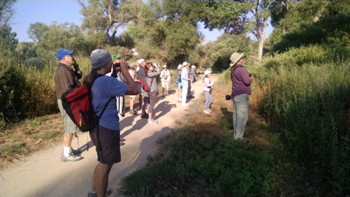
Birding in the COSA
Unless otherwise indicated, our COSA bird walks will all be the second Saturday of the month, except for December, because we will have it coincide with the Christmas Bird Count. During June, July, August, and September they will start at 7:30 instead of 8:30. Watch the monthly email update (sign up at the top of the page), the field trips page on our website, or local media for confirmation, updates on leader(s) and meeting time. Or, contact Hillary (below).
The Conservation Open Space Area is being developed for wildlife and the community by the Bishop Paiute Tribe. We are keeping species lists and observing behavior as well as identifying birds, for the purpose of creating bird lists for the site. For more information, read this article on the COSA in the March-April 2013 Sierra Wave newsletter. There have been surprises every month so far - come find out what new birds we'll see next time!
All are welcome - these walks are for birders of ALL LEVELS, beginners included! We will bring extra binoculars and field guides to share.
Please meet at 7:30am in September and/or 8:30 am in October at the BLM/Forest Service Building on West Line Street in Bishop. Contact Hillary Behr for more information, or if you are interested in leading a future monthly walk: Hillary.behr@bishoppaiute.org or call (760) 920- 5287.
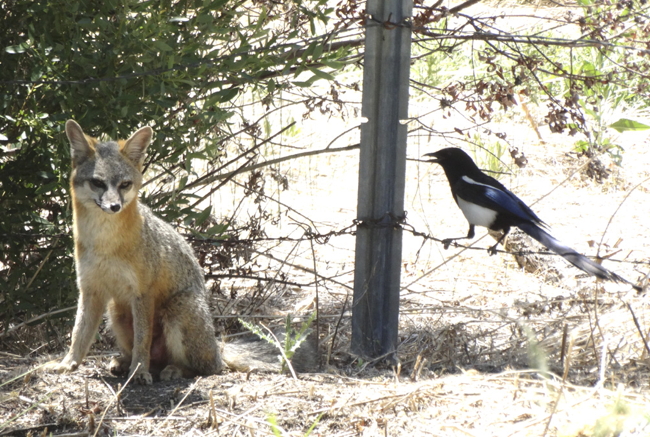
A Black-billed Magpie mobbing a female gray fox in the COSA - photo by Nancy Overholtz
Back to Top
CALL FOR VOLUNTEERS:
Exploring a Wetland, September 15, 16, and/or 18
Eastern Sierra Audubon is partnering with The Bishop Paiute Tribe, Eastern Sierra Institute for Collaborative Education, US Forest Service, Sierra Nevada Conservancy, and Eastern Sierra Land Trust again this year to put on a 3rd grade field trip to the Tribe's COSA called "Exploring a Wetland".
Students will spend a day on the Tribe's Conservation Area learning about native fish, wild plants and their uses, mapping and the herbarium in the Forest Service building, and birding! We need volunteers on September 15th, 16th, & 18th from 8am- 1pm. If you are interested in teaching 3rd graders to use binoculars and sharing the excitement of birding, email Hillary at hillary.behr@bishoppaiute.org. Thanks!
Back to Top
Inyo Craters Fall Forest Migrant Field Trip, Tuesday, September 16
Leader: Santiago Escruceria
A gentle walk through pine forest, ending at the Inyo Craters. We will be looking for Fall migrants, including (possibly) Evening Grosbeaks, Flycatchers, Finches, Red Crossbills, and more. The trip should last about two hours.
Meet at 8:30 am at the Inyo Craters trailhead parking lot.
Directions: from Mammoth Lakes, take the Mammoth Scenic Loop from Minaret Road (203), to a marked turn-off for Inyo Craters on the left, then follow the dirt road to the parking lot. It is well-marked. Coming from the north, take the scenic loop from Highway 395 and the turn-off will be on your right. Click here for a map.
Bring: binoculars, field guides, water, jacket, hat and snack.
Contact Santiago for more information: 760-647 6127 / guadualito@me.com
Back to Top
Mono Lake County Park Field Trip, Tuesday, September 23
Leader: Santiago Escruceria
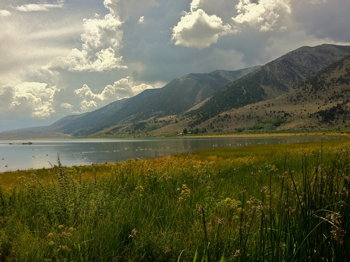
Mono Lake County Park - a beautiful place to look at birds!
On this nice flat walk, we will explore different habitats, including riparian, open field (grass and sage), and Mono Lake’s shoreline. We will be looking for Eared Grebes, Osprey, Avocets, Ducks, Woodpeckers and migrant birds! The trip should last about two hours.
Meet at Mono Lake County Park at 8:30 am at the park’s parking lot.
Bring: binoculars, field guides, water, jacket, hat and snack.
Contact Santiago for more information: 760-647 6127 or guadualito@me.com
Back to Top
Other Organizations' Events of Interest
Sierra Club Range of Light Group Bird Outing, September 13th
Local bird experts lead a morning of birding in the Mammoth Lakes area. Look for resident birds, migrants, and there may be some surprises. Location to be determined pending weather conditions and bird activity.
Meet 7:45am at Mammoth Lakes Union Bank. Binoculars necessary. No dogs. Contact Karen (949-240-3956), kmschlaep@cox.net or Dick (760-709-5050), rhihn@gmail.com
Back to Top
The Great Sierra River Cleanup - Saturday September 20, 9am-Noon
Enjoy the river winding free; put trash where it's supposed to be!
The Great Sierra River Cleanup is the largest volunteer effort in the state to remove trash and debris from watersheds throughout the 400 mile Sierra Nevada range.
Hosted by the Sierra Nevada Conservancy, partner organizations like the Eastern Sierra Land Trust and the Bishop Paiute Tribe, organize volunteers to work together to clean the rivers, streams and lakes that supply the State of California with over 60% of its water.
Over the past five years, this event has hosted nearly 19,000 volunteers to clean up over 1,700 river miles in the Sierra Nevada range. Not to mention it has facilitated the removal of 600 tons of trash and recyclables, from cigarette butts to whole couches.
This year the event will be held Saturday, September 20th from 9am-12pm. Bring outdoor clothing, sturdy shoes, sunscreen, a hat and water. Snacks will be provided.
To sign up, contact Bishop Paiute Tribe Watershed Project Coordinator and AmeriCorps member Brittni Brown at Brittni.Brown@bishoppaiute.org.
Back to Top
Sage Grouse Protection Stewardship Day, Wednesday October 8th
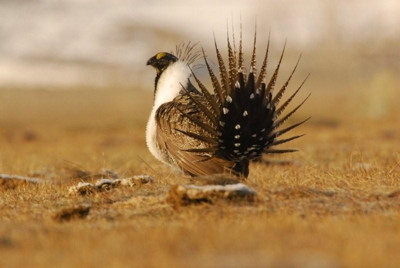
Sage Grouse, photo by Donna Willey
from her May 2008 Eastern Sierra Birds post on Sage Brush Terrain
Eastern Sierra Audubon members are invited to join Eastern Sierra Land Trust in this project to help protect Sage Grouse.
What: Work day on a scenic ranch property to benefit Sage Grouse (remove an old fence and install 3 miles of fence markers to prevent birds from flying into them).
When: Wednesday October 8th. This will be an all day event starting at 8am.
Where: Between Virginia Lakes and Bridgeport in the Sierra Nevada.
Details: An opportunity to visit a beautiful private ranch property and lend a hand to help make the operations more sage grouse friendly. Lunch will be provided! Please let us know in advance if you have any food allergies/concerns. Please wear appropriate field attire. This means closed-toe and comfortable shoes, hat, sunscreen, long pants and/or shirts, and sunglasses. Please bring water and leave pets at home.
*RSVP is required by September 20th at 5pm to attend.
Please contact Education Coordinator and AmeriCorps member Sara Kokkelenberg to RSVP and for meeting location and additional information.
Back to Top
Back to Top
Features
President’s Message
“How shall we live?
As though we believe in the future”
— Janisse Ray
Not long ago, the Eastern Sierra Audubon Society board spent several hours together at the Crowley Lake Community Center. We have one long meeting each summer to talk about the chapter’s activities in the past year and lay plans for the future. More than once on this day I found myself thinking of how fortunate I am to have the opportunity to work with such a talented, creative, dedicated, visionary and FUN group of people. Ideas were flying around the room and hands were raised to take on responsibilities for helping to move those ideas forward.
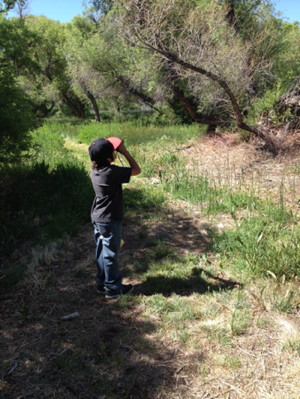
A Birds-in-the-Classroom student checks out a Red-winged Blackbird on the Bishop Paiute Tribe’s Conservation Open Space Area
The phrase “the Audubon experience” was used several times. We talked about what that involved and how we can share the values of Audubon with the people of Inyo and Mono Counties. There are so many aspects to this.
You have the birds in the classroom program that brings the magic of winged beings to elementary school students and gets them outside, armed with ESAS binoculars, to visit up close and personal with our birds. Thank you to the many volunteers who generously gave of their time to allow us to expand the program, beyond our original Bishop Elementary presentations to visit Lee Vining, Benton and Big Pine youngsters this past year.
There is the collaboration between ESAS, the Bishop Paiute Tribe, and Bishop schools to develop a program of outdoor education activities at the tribe’s Conservation Open Space Area. Hats off to Hillary Behr for spearheading a continuously expanding list of events, including the fall “Exploring a Wetland” day, a yearlong “Taking Root” program for third grade classes, monthly birding trips, and providing ESAS binoculars for use by the Toyabe Health Clinic in a COSA walking program. I am so proud of our participation in encouraging community residents and tribal members to experience what is becoming recognized as an outstanding natural resource.
The Audubon experience includes working collaboratively with stakeholders to find a mechanism to assure long-term habitat protection and stewardship at Owens Lake and develop guidelines to help protect Sage Grouse from the effects of too much love from eager observers. There are the amazing pollinator plantings at the Bishop Community Garden (kudos to Rosie Howard) and our work to promote wildlife friendly landscape and garden practices in the Eastern Sierra.
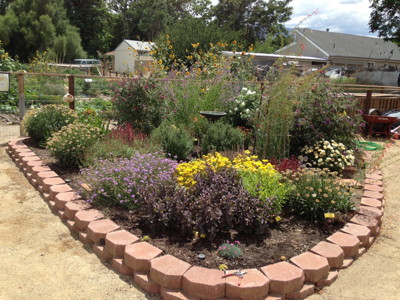
The Bird and Butterfly Pollinator Garden in bloom at the Bishop Community Garden - photo by Rosie Howard
Audubon has supported research relating to gulls and Osprey populations at Mono Lake and is
a sponsoring partner of the annual Mono Basin Bird Chautauqua. People experience Audubon through our field trips and member programs and the chapter now awards scholarships to two graduating high school seniors so they can continue their education beyond high school.
That is a lot. It is a big responsibility to be a part of an organization that is capable of making so many positive contributions to its community. The board talked a long time about how we can make sure we can provide those contributions on a consistent basis and bring more folks into the Audubon tent. We are working to develop a new suite of outreach materials: brochures, interactive activities for an Audubon table at community events and changeable message boards. All of these will feature our awesome new chapter logo (thanks to Serena Johnson and Logan Parsons). We have a
terrific website (yea! Maggie Wolfe Riley) and are looking to improve and expand our electronic and social media communications with our members and community. The board would like to offer “Birds in the Classroom” to more schools and to use the Bishop COSA project as a template for the establishment of outdoor education programs in other communities in Inyo and Mono counties. It is rare that I feel more energy at the end of a three hour meeting than I did at the beginning, but that was the result on that Sunday; I can’t wait to get to work.

ESAS Board member Bart Godet
awarding an ESAS scholarship to a deserving high school senior
So, what are your favorite Audubon experiences? What do you think we should be doing? Who do we need to involve and how do we reach them? Please share your thoughts with me or any of our amazing board members. Our attitude here is “bring it on…let’s check it out and give it a try.”
Is there some way you could see yourself in this picture? Would you like to help carry this forward: help with a field trip; suggest a speaker; help mentor a third grade class or docent a student bird walk; or work with community outreach? Come on down and let’s see what we can do together.
This is going to be an exciting and rewarding year for this chapter. It is an honor and a pleasure to be able to be a part of all this. Check out our newsletters and website to see what we are up to. Become you own part of the Eastern Sierra Audubon Epxerience.
Pete Pumphrey
Back to Top
2014 Inyo County Summer Records & How to Contribute
[Birds in bold type have a photo in the article (or linked) - click on any photo to see all in a slideshow]
By Tom & Jo Heindel
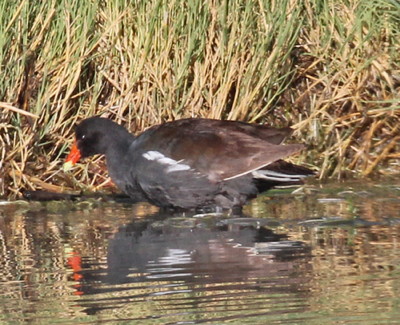
Common Gallinule, photo by Tom Heindel
The Summer season for birders is June and July, which this year flashed by just as fast as always but was cooler than usual. While we catch our breath before the autumn avian goodies arrive, we can reflect on this past summer and the unexpected bird species that were observed, documented, and became Inyo County avian records.
This past summer had, as each season does, many exciting birds reported. A male Ring-necked Duck was photographed at the Bishop Wastewater Treatment Plant on 11 June (C&RH). A female Lesser Scaup was found at Klondike Lake 28 July (original observers failed to submit any documentation) and later in the day photographed (TSH). These two species are fairly common in winter but typically absent in summer. A Common Loon is a regular spring and fall migrant but is casual (seen less than seven years in a decade) in summer. One in basic plumage was photographed at Tinemaha Reservoir 25 May (KH-L), summered, and was joined by a second bird in alternate plumage in July (multiple observers). Another casual visitor was a Common Gallinule photographed at Klondike Lake 17 June (TSH) that remained through 30 June (C&RH, J&DP) and six rare Black Swifts were west of Big Pine 28 June (J&DP). Mountain Chickadees and Brown Creepers are common in our mountains all year and some winters they descend to the valley floor but both species were reported in Bishop this summer when casual (C&RH, J&DP) and an American Pipit, for which there are very few breeding records, was seen feeding young near Cirque Lake, west of Lone Pine 14 June (SLS). The amazing Curve-billed Thrasher continued being photographed at Starlite through June (J&DP, JTZ) where it set up residency two years ago (R&KS). A casual Summer Tanager was photographed at Glacier Lodge 29 July (TSH) as was a rare Indigo Bunting at Division Creek 20 June (J&DP) and finally, a rare male and female Lawrence's Goldfinch were at Starlite 25 June (J&DP). While there were other good avian finds, these were the highlight species and all were supported with images, audio files, and/or documentation that validated the accuracy of the identifications.
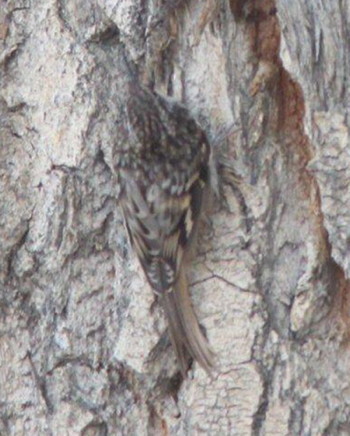
Brown Creeper, photo by Debby Parker
Each season, county coordinators for the journal North American Birds prepare a seasonal report for the editors of their region. County coordinators could not submit a report without the help of birders who turned their rumors into records by supplying evidence, such as images, sound recordings, or written descriptions, of their claims. This network of coordinators extends throughout Canada, the U.S., Mexico, and Central America with the purpose of informing the public of significant ornithological occurrences during each season. If you find a species that is rare or casual, for the date, location, elevation, number, etc., it should be reported. We urge you to consider sharing your observations with others and submitting your evidence to the county coordinators for publishing consideration in the North American Birds journal. If the sighting occurred in Mono County contact Kristie Nelson (storm_petrel@hotmail.com) or Tom & Jo (tjheindel@gmail.com) if in Inyo County.
The Birding Calendar looks somewhat different than the calendar used over most of the world! The "birding" seasons are graphed here:
County coordinators have to get their reports to the regional editors by the middle of the month following the end of the season. This is a tight turnaround, especially in spring and fall, so they appreciate receiving your sightings by the tenth of the month. Please do not assume that your Facebook or eBird entries will suffice…they must be personally submitted to the county coordinators. (Email or Eastern Sierra Birds Google Group posting is okay. Because we receive the Eastern Sierra Birds submissions as they are posted, we don't need to be copied on them. If they include images and/or descriptions of the species, they are downloaded and added to the NAB report and Inyo County Avian Archives.)
Some species require just a few sentences but others, because of their rarity or their difficulty to identify correctly, require much more and the maxim, "A picture is worth a thousand words," was created for birders! (even blurry photos that show field marks help a lot!) Formats for writing bird descriptions are available online or request one from us if you'd like some guidance. Read more about this, plus download a list of which species require further documentation, on our North American Birds webpage.
Have a great Fall season and we look forward to collating all the evidence the Eastern Sierra birders gather for archiving in perpetuity!
Contributors for summer report: Jim and Debby Parker, Chris & Rosie Howard, Tom Heindel, Kelli Heindel-Levinson, Rick & Karen Scott, Susan Steele, and Jerry Zatorski–our gratitude to all!
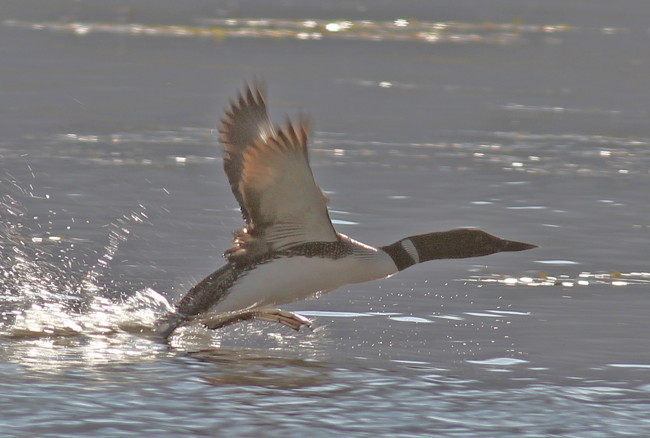
Common Loon, photo by Tom Heindel
We solicit your help in making each seasonal report more complete so consider submitting reports of interesting and unusual sightings of rare or very rare species, along with documentation and/or images to tjheindel@gmail.com. Information on which birds need extra documentation, and how and when to submit, is on our Inyo Bird Checklist page.
Tom and Jo Heindel have contributed a vast amount of their knowledge to the Wave Newsletter over the years (from 1993 on!). Those articles have been archived for reference, here: Heindel's articles and season highlights.
Back to Top
Native Bees Need Native Plants
Also published in the CNPSBristlecone Chapter newsletter
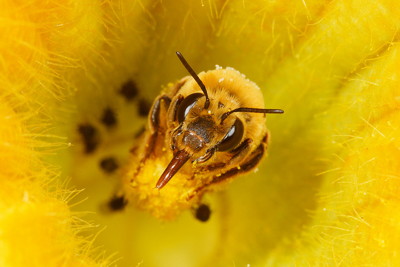
Long-horned Squash Bee, Peponapis pruinosa
Photo by Rollin Coville
On your next wildflower hike, take notice of the unusual, diverse winged insects pollinating the colorful blooms. Are they all honey bees, or are they one of 1,600 native bee species that call California home? While honey bees tend to dominate the bee landscape, they are not native to North America, but were brought here by early European settlers. California’s native bees have evolved over thousands of years with the diverse flora over our heterogeneous landscape. The various shapes, sizes, and colors of blooms have adapted to fit with their most preferred pollinator, native bees. Bees are built for pollination and have specialized hairs on their bodies in which to carry pollen back to their nests and feed to their developing young. They also time their emergence to sync with the bloom of their preferred plants. This means that as the first spring blooms open, with them comes a group of native bees built specifically to pollinate them, including bumble bees, spring long-horned bees, digger bees, and mining bees. As the season progresses a new group of bees emerge to collect nectar and pollen.
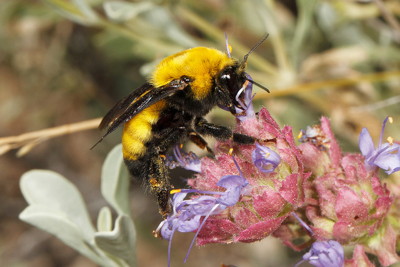
Morrison's Bumblebee, Bombus morrisonii
Photo by Rollin Coville
Many native plants rely on their bee pollinators so they can set fruit and go to seed, which then provides food to a myriad of animals and birds. Bees can be placed in two different groups, either generalists or specialists. Specialist bees have evolved to collect pollen from either one family of plants, i.e. Asteraceae or Malvaceae, or even one genus or species of plants. Their offspring will only survive if they consume the pollen from these specific plants. One famous specialist is the squash bee (Peponapis pruinosa), which requires plants in the Cucurbitaceae in order to survive. Squash bees are common garden visitors as many gardeners and farmers have planted squash, zucchini, and pumpkins all across the U.S. Some flowers may not be able to set seed if their specialist bee is missing and often the reproductive success of both the bees and flowers are tied to each other. Most bees, however, are generalists and can take pollen and nectar from most flowers.
Through our research in the Urban Bee Lab traveling all over California, we have found that native bees have a strong preference for native plants. Most home gardeners, however, plant non-native exotic ornamentals, especially as that is what is found at most plant nurseries. To encourage native bees into your garden, plant a diverse palette of flowering plants, which bloom from early spring into late fall. Plant natives including Ceanothus, Arctostaphylos, and Salvia species, and plant large patches of smaller plants like Penstemon, Achillea, and Lupinus species. For more information on gardening to attract bees, visit www.helpabee.org.
by Jaime Pawelek, UC Berkeley Urban Bee Lab
Jaime Pawelek visited Bishop this past summer sampled bees in all gardens of the Community Garden. The CNPS Native Plant Garden, ESAS Pollinator Garden, and annual (sunflower) garden were the most attractive for bees. Their favorites in the pollinator garden are the salvias, Gaillardia "Oranges & Lemons," shasta daisy, Scabiosa, and Hyssop. She is looking forward to coming a little earlier next year in order to catch more of the early blooming flowers. She says we all did a great job picking plants for the pollinator garden (Thanks Rosie and other Master Gardeners who designed and made the Bird and Butterly pollinator garden a reality!)
See a recent publication of the Urban Bee Lab: http://anrcatalog.ucdavis.edu/pdf/8498.pdf
Also see Eastern Sierra Land Trust's Pollinator Garden Project for help in transforming your Eastern Sierra garden into a pollinator sanctuary! Their list of recommended plants includes MANY that will be available in the Bristlecone Chapter's annual Bishop Native Plant Sale coming up on September 13th at White Mountain Research Center on East Line, 9-11am!
Back to Top
Bird of the Month
Board Member Santiago Escruceria will be sharing a photo of a different bird each month - and all can be seen at the Bishop Paiute Tribe's COSA - join us there on the second Saturday of each month to see these birds and more! See upcoming field trips here.
Red-breasted Sapsucker
The Red-breasted Sapsucker is a medium sized woodpecker with extensive deep red on head and breast, and a bold white patch on wing. The female has a white chin and red throat bordered by black. They have a long bill, which they hold tilted up, and long wings. Their call is a down slurred ‘jeer’ and their drum has an uneven rhythm – like Morse Code! Seen at COSA reserve, and fairly common in aspen groves and conifers.
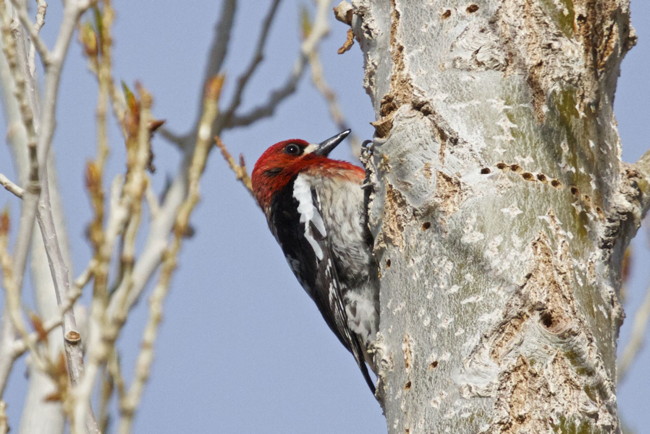
Red-breasted Sapsucker - photo by Santiago Escruceria
Sources:
- The Sibley Guide To Birds. Second Edition, 2014. Written and illustrated by David Allen Sibley.
- The Stokes Field Guide To The Birds Of North America. First Edition, 2010. Donald and Lillian Stokes.
- Birds Of The Sierra Nevada, Their Natural History, Status, And Distribution. 2013. Edward C. Beedy and Edward R. Pandolfino; Illustrated by Keith Hansen
Back to Top
Inyo National Forest Plan
Inyo, Sierra and Sequoia National Forest Plans - NOI POSTED
Don’t miss the opportunity to provide comments and concerns
Reprinted from the CNPS Bristlecone Chapter newsletter/website
The Notice of Intent (NOI) for the Draft Environmental Impact Statement on the three forest plan revisions- Sierra, Sequoia, and Inyo - will be posted in the Federal Register on Friday (8/29). The comment period will be 30 days beginning 8/28/14. The NOI will inform the public of the Forest Service’s intent to prepare and develop an environmental impact statement (EIS) that will revise the forest plans. Our comments will be included and addressed in the NEPA process. The final resulting documents will be three individual Records of Decision for each respective forest’s management plan. Since management plans are typically in place for 15-20 years it is a very important step in the NEPA process – to voice our concerns.
The Inyo National Forest will hold a public scoping workshop on Thursday, September 18, 6-8pm at the Tri-County Fairgrounds, Sierra Street & Fair Drive, Bishop, CA.
For more information and to review the planning documents go to: www.fs.usda.gov/main/r5/landmanagement/planning
OR, see the individual documents linked below:
This process may seem long and slow but it is important for the Eastern Sierra.
Julie Anne Hopkins
Bristlecone Chapter Conservation Chair
Return to Top
Poetry
Marigolds in Fall
I love to look out the kitchen window at dusk.
You are bright beyond the failing light that finds you.
Your fireworks explode electric orange against your deep green leaves.
Hummingbirds probe your profusion and hunt for hidden treasure.
How can a bee penetrate your petals to pollinate you?
Yet I know they do because every fall after first frost I till your spent fertile blooms back into the soil.
In the spring, there you are again, two reddish stemmed dicotyledons bright and smiling with the promise of keeping the squash bugs at bay.
Thank you for your vigilance and persistence,
But most of all thank you for your beauty.
by Rosie Howard
Go see the Audubon Pollinator Garden at the Bishop Community Garden and enjoy the gorgeous blooms!
Back to Top
Reports
Third Graders Explore Nearby Natural Areas through Birding
Eastern Sierra Audubon's Birds in the Classroom Program
This past May and June, Eastern Sierra Audubon Society (ESAS) offered another year of our Birds in the Classroom program, which has been running for the past 15 years. Through this program, many 3rd graders in Inyo and Mono County learn more about their local area through participating in lessons and field trips on bird identification and how to use binoculars. This year, third graders from Bishop Elementary School, Lee Vining Elementary, Edna Beaman Elementary, and Big Pine Elementary school got to participate.
On June 2nd in Big Pine, fifteen 3rd graders from Ms. Matisse’s class went birding on the playground, school fields, and surrounding areas of trees and sagebrush. Their leader, ESAS board member Bart Godett, recalls that the group’s best find was a mulberry tree with many birds in and around it feasting on the ripe fruit. The students were especially excited about the “fattest” American Robin they had ever seen.
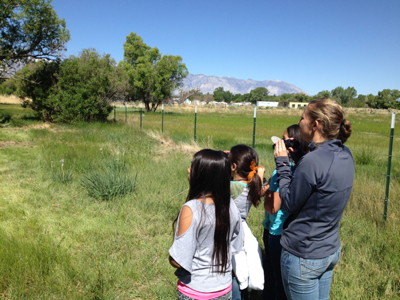
Brittni Brown, AmeriCorps member for the Bishop Paiute Tribe, helps students in Bishop get a glimpse of a nesting House Wren.
In Lee Vining on May 9th, ESAS board members Santiago Escruceria, Pete Pumphrey, and Roberta Lagomarsini took Ms. Silliker’s class of 5th and 6th graders birding on the Lee Vining Creek trail. The students enjoyed Santiago’s jokes, a great variety of birds, and some quiet nature journaling by the shady creek.
On May 30th, at the Edna Beaman school in Benton, nine students from Ms. Ice’s 3rd/4th/5th grade class visited the nearby Benton Ponds to see how many birds they could spot on the water, in the tules, and soaring above them in the sky. ESAS board members Pete Pumphrey, Roberta Lagomarsini, and Santiago Escruceria partnered with Eastern Sierra Land Trust (ESLT) to lead this trip on private land which is preserved by an ESLT conservation easement. ESLT AmeriCorps members Alison Amberg and Sara Kokkenlenberg helped with birding as well as giving lessons on the Wong’s spring snail and archeological history of the site. The group saw close to 20 species of birds, including a ring-billed gull, and found lots of obsidian flakes in the sagebrush around the ponds.
On May 12th, 14th, and 15th in Bishop, all 3rd grade classrooms participated in Birds in the Classroom field trips, as they have since the beginning of the program. Before the trips they had seen slideshows and films about birds, drawn Western Tanagers with the Inyo Council for the Arts Art Docent program, and had a visit from Eastern Sierra Wildlife Care. A big change in the trips this year is that the groups took a walk out their back gate to the Bishop Paiute Tribe’s Conservation Open Space Area (COSA) instead of walking across town to City Park. The students split into small groups with volunteer leaders and wandered beneath the red willows, in the meadows, and around the ponds to spot many great birds. Some bird highlights for the students were a Great Egret, Spotted Sandpiper, Red-shouldered Hawk, Northern Flickers, and Lesser Goldfinches.
Volunteers helped make this special trip happen for all 150 Bishop 3rd graders including: Bishop Paiute Tribe Environmental Office staff BryAnna Vaughn, Billy Barlow, Brittni Brown, and Katie Larsen, local AmeriCorps members Jaryd Block, Alison Amberg, and Sara Kokkenlenberg, as well as community members Sara Steck, Ian Bell, and Amy Leist, and ESAS Board members Hillary Behr and Bart Godett. Big thanks to the Bishop Paiute Tribe for the use of their beautiful and very birdy Conservation Area for the Bishop trips.
Eastern Sierra Audubon would like to thank all of the Birds in the Classroom volunteers. This wonderful program could not happen without you! If you are interested in volunteering to help lead these trips next May, contact info@esaudubon.org.
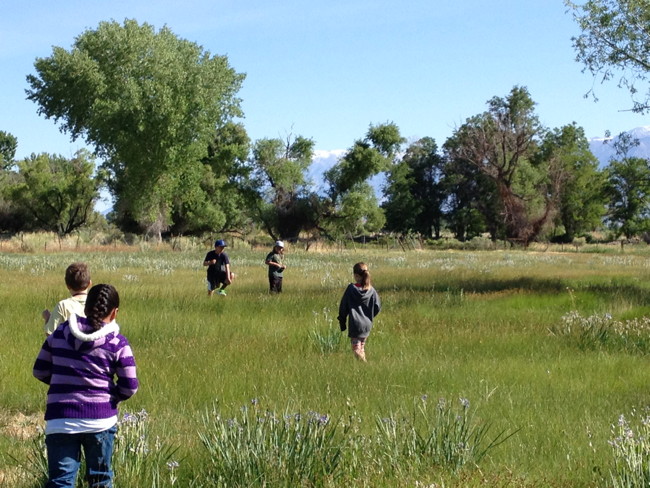
Students from Ms. Greer and Mrs. Samuel’s class are on the lookout for birds as they explore a meadow on the Bishop Paiute Tribe’s Conservation Open Space Area
Eastern Sierra Audubon Society is an all-volunteer non-profit organization based in Bishop. Visit our website or our Facebook page to find out more about our organization as well as local birding field trips and evening programs.
Hillary Behr,
AmeriCorps Member and Wetland Restoration Coordinator,
Bishop Paiute Tribe Environmental Management Office
Back to Top
Report: Owens Lake Fall Big Day, August 21, 2014
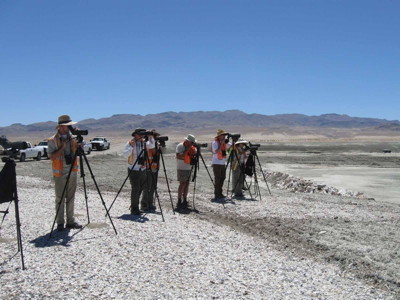
Birders on Owens Lake, Photo by Debbie House
Our Owens Lake Fall Big Day Thursday, August 21 went well. There was a good turnout of volunteers who partnered with LADWP biologists to census all birds on the lake. This is sometimes called "dip sticking" or a "snapshot" of bird populations. There are six lake-wide surveys each year and the data collected is used to manage wildlife habitat as part of the LADWP Owens Lake Master Project. Eastern Sierra Audubon helps in April and August and in fact, began the Big Days. Owens Lake is officially closed to the public due to heavy construction, so we all wore our hardhats and vests and dodged double trailer trucks hauling 20 tons of crushed rock.
Wilson's Phalaropes were common in all flooded cells. They will double their weight via fat in about two weeks and then fly non-stop to the Altiplano of Bolivia and the salt lakes of Argentina. The Wilson's were spinning furiously while feeding and also running in shallow water and along the shore chasing brine flies. In one cell there was a tight group of American Avocets and Wilson's Phalaropes in a feeding frenzy. Looking more closely we learned that they were eating brine shrimp! A few Red-necked Phalaropes were just arriving from the north as well. They will leave and spend this winter as pelagic (open ocean) birds offshore of Peru. Least Sandpipers were the most abundant "peep." There were smaller numbers of Western Sandpipers and a scattering of Baird's Sandpipers. Baird’s Sandpipers migrate in the spring north through the Midwest, but every fall many juveniles fly south through the West. We noticed their wing tips folded back beyond their tails - long wings for long flights.
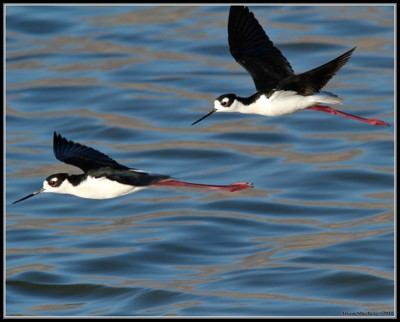
Black-necked Stilts, aka "tuxedoes with sunburnt legs" over Owens Lake, photo by Ali Sheehy
Male and female American Avocets with their slender bills scythed the water searching for invertebrates. The "tuxedo with sunburned legs" Black-necked Stilts walked and picked while Long-billed Curlews probed nearby with impossibly long curved bills. Marbled Godwits, down from their pothole country breeding areas, talked among themselves. Willits flashed jet black and white underwings, Dowitchers imitated sewing machines, White-faced Ibis preened iridescent plumage and the ghostly Snowy Plovers scampered and then stopped on a dime – such ploverness. An immature Peregrine Falcon was in the area. We often see raptors hunting among the flocks of birds at Owens Lake.
The breaking news is that Eastern Sierra Audubon is beginning the nomination of Owens Lake to be a part of the Western Hemisphere Shorebird Reserve Network (WHSRN). It appears to meet the criteria for approval due the large numbers of American Avocets, Least Sandpipers and Snowy Plovers. The three designations in WHSRN are Hemispheric, International and Regional. Owens Lake easily qualifies as an International site. The process of nomination and approval will take a few months, but should be a rewarding project in partnership with LADWP, State Lands and Audubon-California. We give a loud shout out to our members and friends who have worked (played really) on behalf of the birds at Owens Lake for so many years. It’s paying off! Visit the WHSRN website to learn more about this excellent program at www.whsrn.org.
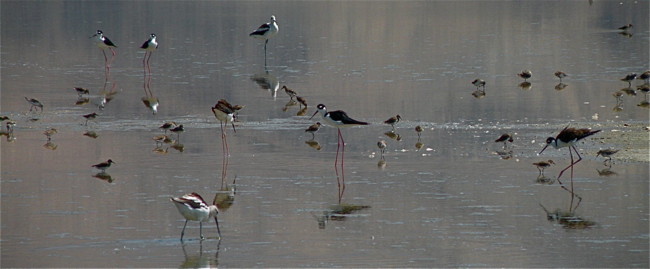
Tuxedo'd Stilts with their sunburnt legs, Avocets scything the water, and "Peeps" - lots of peeps (small sandpipers)
Photo by Mike Prather
Further shorebird reading:
Wind Birds by Peter Matthiessen
Living on the Wind by Scott Weidensaul
www.shorebirdplan.org
Michael Prather
Back to Top
2014 Owens Lake Spring “Big Day” Bird Count Records Second Highest Total Ever
Reprinted from: www.ladwp.com/ladwp/faces/wcnav_externalId/a-w-laa-owenslake-bigdayrecords
Almost 50,000 shorebirds comprised of 20 different species and an overall total of more than 75,000 birds, the second highest total number of birds ever recorded, were counted during the seventh annual Owens Lake Spring “Big Day” on April 23, 2014. Big Day bird counts have been done annually since 2008. The most birds ever recorded in the Dust Control Project area was 114,155 recorded during the Spring Big Day count in April 2013.
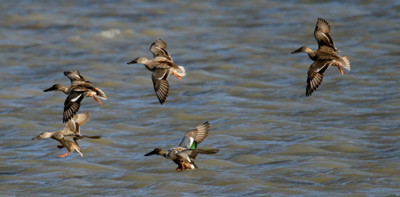
Norther Shovelers on Owens Lake, photo by Gail Klett
LADWP staff, Eastern Sierra Audubon volunteers, and other agencies recorded all bird species and individuals spotted in the entire 42-square mile Owens Lake Dust Control Project Area. Shorebirds comprised 66% of the overall total of 75,550 birds counted during the census. Waterfowl and diving waterbirds, which are typically found in lower numbers than shorebirds in spring at Owens Lake, totaled 1,520 and 3,793 respectively.
Eastern Sierra Audubon Society Education Committee Chair Mike Prather and LADWP Watershed Resources Specialist Debbie House organized the Spring 2014 Owens Lake Big Day. The 21 participants in the census included eight LADWP staff, nine volunteers, and staff from California Department of Fish and Wildlife and Inyo County Water Department.
Although all bird species are recorded during the surveys, the populations of specific waterbird guilds, including shorebirds, waterfowl and diving waterbirds, are of particular interest to stakeholders. Data from Big Day surveys tracks trends in bird use of the Dust Control Project area, helping guide wildlife habitat management decisions while water conservation efforts are implemented at Owens Lake, and while dust control requirements continue to be met.
The data is also used to refine Owens Lake habitat suitability models developed to design and manage Owens lake dust control. Habitat suitability models will also be used to monitor changes in habitat availability for waterbird guilds during implementation of the Owens Lake Master Project Concept, a long-term collaborative project with the goal of reducing the water usage for dust control while preserving habitat for shorebirds, waterfowl, and diving waterbirds.
LADWP would like to thank Mike Prather, the Eastern Sierra Audubon Society and all who participated in the census. For information regarding the use of this data, please contact LADWP Watershed Resources Supervisor Jeff Nordin at jeffrey.nordin@ladwp.com or (760) 873-0431.
The results of the census are available here, along with results for every spring count since 2008: Owens Lake Spring Big Day Counts Compared (pdf).
Regarding the fluctuation in count numbers between years you can observe on the linked table above, Debbie notes that it is important to realize that the areas surveyed during the spring counts varied a little. The entire dust control project area was counted every time, but during some counts, outlying areas such as Cottonwood or Cartago were also counted. This would account for the differences primarily in the number of songbirds between counts.
By Debbie House, LADWP Watershed Resources Specialist, Bishop Office
Back to Top
Conservation Report:
Los Angeles Department of Water and Power Removes Pipes to Help Prevent Wildlife Entrapment
Editor's Note: In our previous issue, we shared information about the dangers of open-topped pipes for birds - see that article (and resources) here: Pipes Are Bird Death Traps!
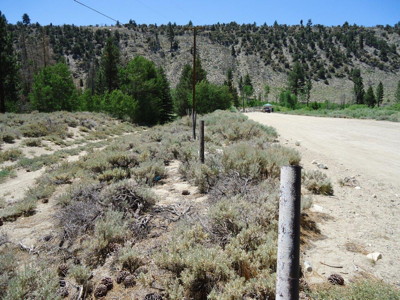
BEFORE: uncapped fence pipes presented a very real hazard to birds and other wildlife
The Los Angeles Department of Water and Power (LADWP) recently removed approximately 300 open-end pipes along Lee Vining Creek in the Mono Basin that could potentially entrap wildlife. Open-end pipes have been found to entrap wildlife such as cavity-nesting birds, small mammals and reptiles. Open-end pipes can be found in the form of uncapped vertical vent pipes, mine markers, fence posts, etc.
In June 2012, Daniel Burnett of Kerncrest Audubon Society contacted LADWP Watershed Resources Specialist Debbie House regarding open-end fence pipes he had observed on LADWP property along Lee Vining Creek during a Mono Lake Chautauqua field trip. He also shared written information regarding the potential dangers open-end pipes present to wildlife.
Ms. House visited the site and found open-ended steel pipes had been used as fence posts around the perimeter of LADWP property. She inspected several of the pipes, and in some of them (especially those near trees), found the remains of birds. Ms. House recommended to LADWP management that the issue be addressed to ensure that wildlife would not become entrapped in the future.
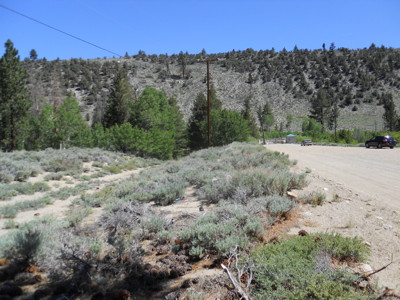
AFTER: much better!
The methods that LADWP Construction considered to address the issue included capping the pipes, cutting the pipes off at the base, or complete removal of the pipes and their concrete foundation. Since the fencing was in poor condition and no longer needed in the area, capping the pipes was not prudent. LADWP Construction decided to remove all of the pipes, their concrete foundation, and the old barbed wire fencing from the area. The concrete was recycled and the pipes will be reused when possible. Because there were approximately 300 fence posts in the area, each encased in concrete, this was a large effort, and required three constructions crews one week to complete. The area now looks cleaner and poses fewer hazards for wildlife.
Thank you to Mr. Burnett for bringing this to our attention, and to the entire LADWP staff for their support in this project.
Submitted by Debbie House,
Watershed Resources Specialist,
Los Angeles Department of Water and Power
Back to Top
Taking Care of Business
Welcome New and Rejoining Members!
Thank you to the members who recently joined or renewed their membership!
We'd like to take a moment to promote Chapter Memberships: You may not be aware of this, but 100% of Chapter Membership dollars stays locally in the Eastern Sierra, supporting local education, youth, conservation, and programs. If you don't need Audubon Magazine, consider joining or renewing as a Chapter-only member, or better yet, as both Chapter and National! We do get support from National Audubon, as well, so any membership helps, and is money well-spent toward bird and wildlife conservation and education, and we thank you!
Your membership donations help keep this chapter alive. We get 8-10 renewing members a month, and from 3-5 new members. Your membership dues make it possible for us to offer and support great educational and recreational events throughout the eastern Sierra. Thank you!
If you would like to join and help support Eastern Sierra Audubon, there are two ways you can do it:
- Join as a National Audubon Society Member, designating ESAS as your chapter affiliation. Includes Audubon Magazine subscription. This is $20 for the first year, and goes up to $35 annually thereafter.
- Join as an ESAS Chapter-only Member for $20 per year. 100% of your donation stays here in the Eastern Sierra this way. Your chapter membership is a way to give back, and show your appreciation for all that ESAS does, and to help support our mission locally. Your membership helps pay for scholarships, programs, special events, education programs, research, and more. THANK YOU for your support!
Click Here for a membership form to join or renew!
Join National Audubon - your zip code will associate you with the chapter nearest you.
Back to Top
How You Can Help ESAS: Four R’s (and a V)
Renew your membership (or join): The money from your membership dues is what helps us bring great evening programs, special events, - educational programs, trips, this website, and more to the community - we need your support!
Recycle at Manor Market and tell them to donate the money to Eastern Sierra Audubon.
Respect property and get permission to bird on private or restricted access property.
Repeat: Spread the word about programs and events, encourage others to join and participate.
Volunteer: Come to a board meeting and consider volunteering for an open board position! We welcome new board members, and we also always need volunteers for Birds in the Classroom, participants in bird counts, Bird-A-Thons, etc.
Message from the Editor
Our next newsletter deadline will be October 15th for the
November-December issue, and of course you are always welcome to send submissions for future newsletters
and also the monthly email at any time.
We send out about one email each month to remind you of upcoming events - if you are not
on our email list, please
add yourself so you don’t miss anything!
If you send items to the newsletter
editor by the last week of any month, we’ll make sure they get included in
the next issue.
All of our content is supplied by our awesome members... if you have any ideas about articles you’d like to see, or better yet, if you have anything to share for newsletter publication, whether an article, a news item, update, correction, poem, essay, artwork, photo, field trip report, neat birding experience, letter, etc, please send it, along with any comments or suggestions, to the newsletter
editor. We’d love to hear from you!
You may send items for inclusion in the newsletter at any time, but please
send any timely items to arrive before the first of the month, so they can
be included in the monthly email update.
Thanks for reading, and happy birding!
Maggie Riley, Newsletter Editor
Back to Top
Calendar for September-October
Back to Top
Final Shot
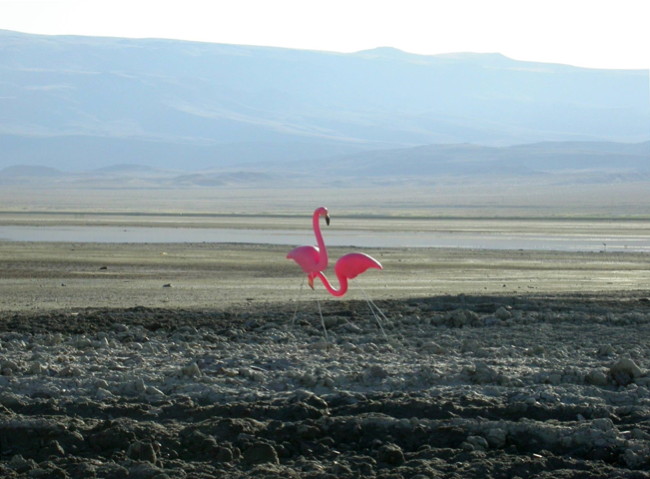
Spotted on Owens Lake - According to Mike Prather, "Once discovered we followed this pair for a full field season, as they appeared to move from place to place. There never was any indication of nesting."
Back to Top



